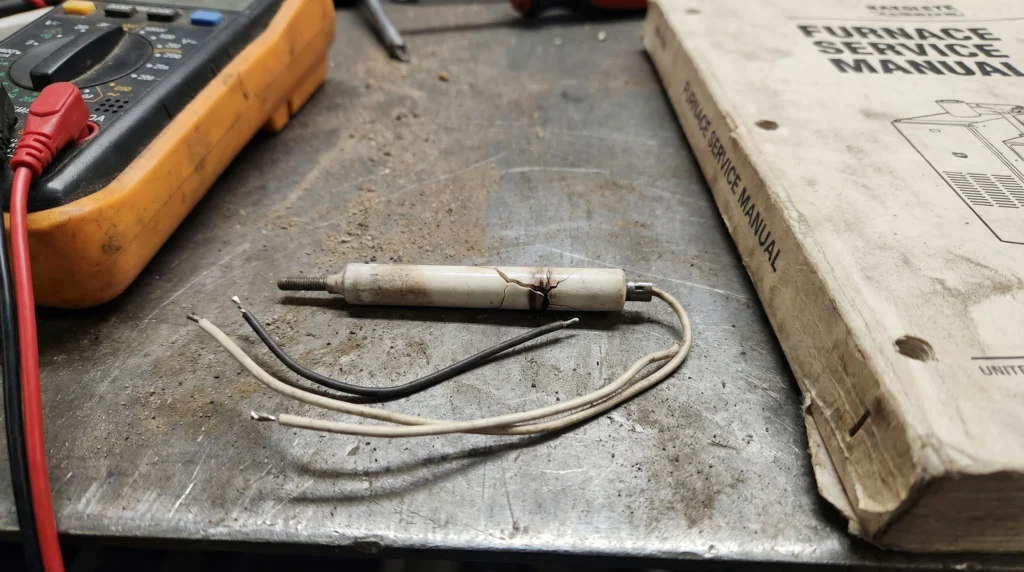A Small Backup Part That Prevents Big Winter Breakdowns
When a furnace fails to start on a cold Colorado morning, a small part is often to blame: the hot surface igniter. Keeping a spare on hand is a simple way to “insure” your furnace against sudden breakdowns.
Hot surface igniters are a key ignition component in most modern gas furnaces. By understanding how they work, how long they last, and why a backup is helpful, you can avoid surprise no-heat calls and stay more comfortable all winter.
What Is a Hot Surface Igniter?
Silicon carbide igniters, commonly called hot surface igniters, are electrical parts used in most newer gas furnaces. They replace old standing pilot lights with a safer and more efficient ignition method.
Each time the furnace starts, the control board sends power to the igniter. The hot surface igniter glows white-hot, reaching roughly 2,156°F to 2,426°F. At that temperature it can easily ignite the gas burners that heat the air in your home.
How the Igniter Fits into the Heating Cycle
During a normal heating cycle, the hot surface igniter works in a simple, repeatable sequence.
- The thermostat calls for heat.
- The furnace control board energizes the hot surface igniter.
- The igniter heats up and begins to glow.
- The gas valve opens and the burners ignite off the glow of the igniter.
- Warm air moves through your ducts and heats your home.
How Long Does a Hot Surface Igniter Last?
Under normal conditions, most hot surface igniters last about 3 to 5 years. However, actual life depends on how often your furnace cycles on and off.
Why Hot Surface Igniters Wear Out
During the heating season, your furnace may cycle many times each hour to maintain the temperature on your thermostat. Each cycle energizes the hot surface igniter. As a result, the igniter goes through a lot of heating and cooling.
High-efficiency furnaces often cycle about 3 times per hour. Older or lower-efficiency furnaces can cycle 6 or more times per hour. Over a full year, your hot surface igniter may be energized tens of thousands of times.
Over time, this repeated heating and cooling makes the igniter’s filament brittle. Eventually it cracks or breaks and the furnace can no longer light. Unfortunately, this often happens during the coldest weather, when your furnace is working its hardest.
Why You Should Keep an Extra Hot Surface Igniter on Hand
It is much better to have a hot surface igniter and not need it than to need one and not have it. When an igniter fails, the furnace will not light, and your home can cool down quickly.
Availability Can Be a Challenge
There are many brands and models of furnaces. Igniter designs and part numbers change over time. If you have an older furnace, it may take extra time for a contractor to locate the correct hot surface igniter. During a cold snap, that delay can be stressful for you and your family.
A Low-Cost “Insurance Policy”
A simple solution is to purchase a spare hot surface igniter that matches the exact make and model of your furnace. Store it in a safe place near the unit. Then, if your igniter fails, your HVAC technician already has the correct part on-site. This can reduce downtime and help restore heat much faster.
Maintenance Tips to Help Your Igniter Last Longer
There is a normal life expectancy for hot surface igniters, but good maintenance can help protect them. In addition, it can extend the life of other furnace components.
Simple Ways to Support Your Furnace
- Schedule routine furnace tune-ups. Regular service by a qualified HVAC company helps verify safe operation and proper ignition every season.
- Change furnace filters on schedule. A clean filter lowers strain on the blower and heat exchanger. It also supports steady airflow through the furnace and duct system.
- Keep your air ducts clean. Clean ductwork helps your furnace move air more efficiently. As a result, ignition and blower parts may experience less stress over time.
Together, these simple steps can extend the life of your hot surface igniter and help your furnace deliver safe, reliable heat throughout the winter.
A Small Part That Makes a Big Difference
A hot surface igniter is a small and inexpensive part, but it plays a big role in keeping your home warm. By understanding how it works, maintaining your furnace and duct system, and keeping a spare igniter on hand, you can be better prepared for the heating season.
Talk with your HVAC professional about the correct hot surface igniter for your furnace. You can also ask how regular maintenance and clean air ducts can help protect your system for years to come.

